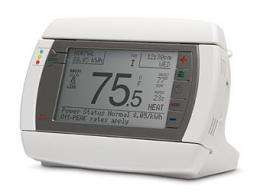Listening to the Price of Power: New Thermostats Could Save Billions

A new generation of inexpensive programmable thermostats with the capacity to communicate may provide a simple and versatile tool for addressing California’s complex, billion-dollar summer peak energy demand problems. Engineering professor David Auslander—working with utility companies, engineers and policy wonks—has created a new set of design rules for the programmable communicating thermostat (PCT) that could help pave the way for greater energy efficiency in homes.
Energy specialists have long known that programmable thermostats (PTs) have the potential to save homeowners money, reduce the need for new power plants and shrink the amount of pollutants and climate-altering CO2 pumped into the atmosphere. Originally deployed during the oil crisis of the 1970s, PTs and their digital descendants permitted consumers to instruct their thermostats to turn down the air conditioning at night when occupants were sleeping and during the day when no one was home.
“We expected those early thermostats to save a lot of money and energy,” says Ronald Hofmann, a senior advisor for the California Institute for Energy and the Environment and advisor to the California Energy Commission (CEC), which funded Auslander’s research. “But only if people used them. And unfortunately, fewer than 20 percent of Californians took, or take, the time to program their thermostats.”
Energy Star, a government-backed program that gives efficiency ratings to appliances, last year withdrew its “high” rating from PTs because their owners either find them too confusing to set, or just don’t bother to try, says William Burke, the lead grad student on Auslander’s team. That reluctance and confusion cost California and energy consumers billions of dollars each year.
The new approach addresses this problem by augmenting the communication component to the PCT, making these devices more user-friendly, responsive to energy pricing and independent of specific communications media. In developing the new design, Auslander and co-PIs, engineering professors Paul Wright and Richard White, worked closely with state regulators, private industry and policy experts.
Some time over the next five years, California’s major utility companies will install in homes new electric meters that can record usage on an hourly basis. The new communicating thermostats would receive hourly updates about electricity prices through a built-in module, Hofmann says; consumers would be able to program them to automatically minimize cost while maximizing comfort. Data entering the PCT can come from the utility through the meter, from the Internet through a router or over the airwaves.
If the user interface were easy enough to use, Burke says, customers could save money by programming the thermostat not only to regulate air conditioning and heating, but also to communicate with appliances, directing them to work when electricity is cheap and rest when it is dear. Burke, a fifth-year doctoral student in mechanical engineering focusing on control of intelligent systems, is developing algorithms that could help consumers simply profile their consumption habits and priorities and let the software devise the best strategy for implementation.
Alternatively, consumers could let a third party program their thermostats remotely, via the Internet, and pay for the service with some fraction of the savings gained by using less electricity, Hofmann says. Essentially, you would be downloading cost-saving “lifestyle” schedules and strategies for your thermostat and other appliances.
The most dramatic savings to the state may come long before the utility companies succeed in actually installing smart meters, though. The new thermostats could receive FM-radio data system (RDS) transmissions, for instance, informing users when the grid is approaching peak load. This happens only on a few hot summer days each year, but meeting the demand is very expensive to the state.
California's peak daily power usage is generally somewhere between 35,000 and 40,000 megawatts of electricity a day, generated mostly by a combination of nuclear plants, hydroelectric and combined-cycle natural gas-fired plants. But on those few sweltering days, when air-conditioning consumption is high, the utilities must generate 50 percent more electricity by firing up older, dirtier and more expensive fossil-fuel power plants.
Sometimes the capacity to meet this demand even has to be bought at exorbitant cost from outside the state. On extreme occasions, as during the 2001 heat wave, rolling blackouts must be imposed, taxing not only the state’s coffers but also its ability to do business, its reputation and its quality of life. The cost of reserving “peaker” plants for only a few hundred hours of service a summer can be more than one billion dollars annually.
A better strategy, the CEC believes, is known as demand response: using communications and information technology, utilities can signal consumers’ thermostats that the grid is stressed and ask them to reduce consumption. To speed the transition to residential demand response, the CEC backed Auslander’s project to include the creation of design standards that would work for industry, consumers and utilities.
A customer could set his or her thermostat so that, when it receives a warning from the utility that the region is nearing grid capacity, the PCT would automatically raise its temperature setting by a few degrees. If they choose to pay the price, customers can ignore the signal and set their own thermostat; they, not the utility or the government, retain the final say in the temperature set point.
Most customers, Auslander predicts, will gladly cooperate by adjusting their set points. And the combined effect of one degree or two of adjustment spread across large regions will often be enough to avert rolling blackouts.
“While it might seem invasive to some,” he adds, “it’s a lot less invasive than having your lights go out and your computer shut off.”
Source: UC Berkeley, Innovations, Marketing and Communications Office

















